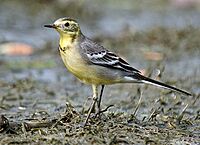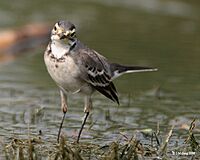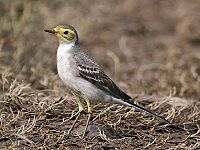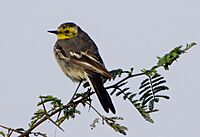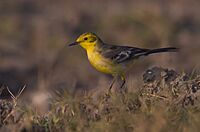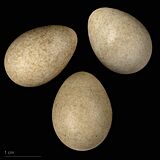Citrine wagtail facts for kids
Quick facts for kids Citrine wagtail |
|
|---|---|
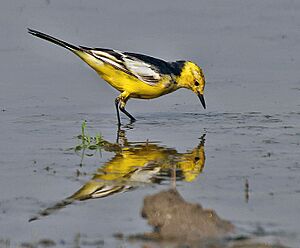 |
|
| Male Weigold's citrine wagtail (M. c. calcarata) in breeding plumage Keoladeo National Park, Bharatpur (Rajasthan, India) |
|
| Conservation status | |
| Scientific classification | |
 |
|
| Range of M. citreola Breeding Resident Non-breeding | |
| Synonyms | |
|
Budytes citreola (Pallas, 1776) |
The citrine wagtail (Motacilla citreola) is a small, colorful songbird. It belongs to the Motacillidae family, also known as the wagtail family. These birds are famous for their long tails that constantly wag up and down. The citrine wagtail gets its name from its bright yellow colors, especially on its head and belly.
Contents
What's in a Name? The Citrine Wagtail's Story
The word citrine means a yellowish color, like a lemon. The scientific name citreola also means "lemon yellow" in Latin. Both names perfectly describe this bird's bright feathers.
Why is it Called Motacilla?
The first part of its scientific name, Motacilla, is a Latin word. It means "to move about." People in medieval times thought cilla meant "tail." So, the name became linked to the bird's wagging tail.
What Does a Citrine Wagtail Look Like?
The citrine wagtail is a slender bird, about 15.5 to 17 centimeters (6 to 6.7 inches) long. Its long tail is always wagging, which is a key feature of all wagtails.
Male Citrine Wagtails in Breeding Season
When it's time to breed, the adult male citrine wagtail looks very striking.
- Its back is grey or black.
- It has white markings on its wing feathers.
- Its belly and entire head are a bright, sunny yellow.
- The back of its neck (nape) is black.
Citrine Wagtails in Winter
In winter, the yellow colors of the male bird become a bit lighter. Its head turns brownish, but it still has a yellowish stripe above its eye. Female citrine wagtails generally look like less brightly colored males, especially in winter.
Where Do Citrine Wagtails Live and Travel?
Citrine wagtails breed in the central parts of Europe and Asia. They prefer wet meadows and cold, treeless areas called tundra.
Their Winter Journey
When winter arrives, these birds fly south. They migrate to warmer places like South Asia, often settling in high mountain areas.
Expanding Their Home Range
Recently, the citrine wagtail has been spreading its range westwards. It is now sometimes seen in western Europe, though it's still rare there. These birds seem to extend their long journeys rather than just getting lost along the way. For example, in Bhutan, which is on one of their migration paths, they are very rare visitors. They usually don't stay for long.
How Do Citrine Wagtails Live?
The citrine wagtail is an insectivorous bird, meaning it eats insects. It likes open areas near water, such as wet meadows and marshy lands.
Nesting Habits
These birds build their nests on the ground. A female citrine wagtail usually lays 4 to 5 speckled eggs.
Gallery
-
Female in breeding plumage, Narenderpur near Kolkata (West Bengal, India)



